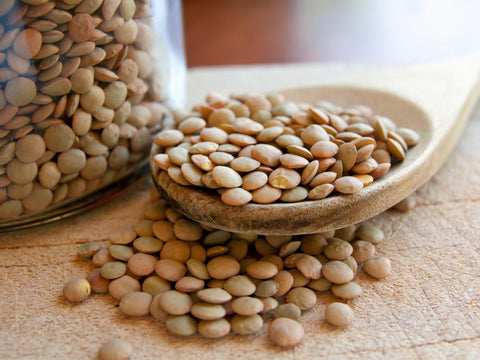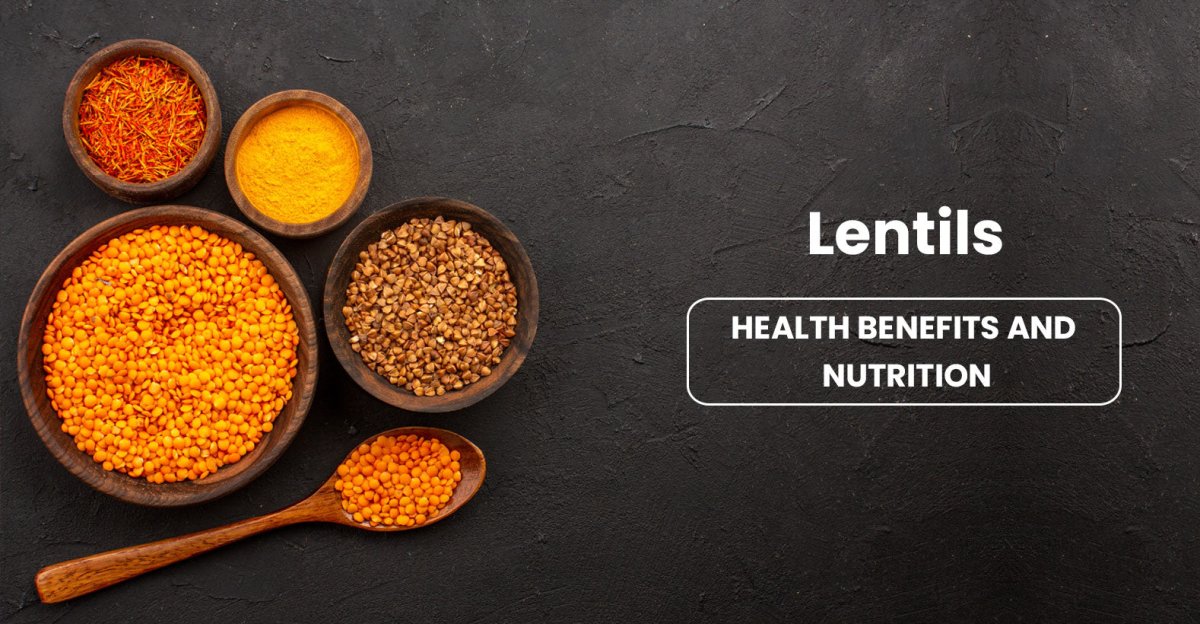Lentils are one of the oldest and excellent healthy foods on the earth. There are various variants of the lens-shaped bean. Brown, green, and red are the most common colours. Gluten-free food is popular among dietitians since it is high in nutrients, and its delicate flavour makes it the ideal canvas for different foods and flavours, according to chefs. Lentils are a convenient and quick source of high-quality protein for many people worldwide due to their low cost and ease of preparation. Lentils are high in iron and magnesium, potassium and Vitamin B, making them ideal for vegetarians. Lentils are both environmentally and economically favourable. Now you will look at how lentils may advance your health and their nutritional value and how to integrate them into a healthy diet.
Lentils Nutritious:
Lentils are a cheap and quick way to add protein to various dishes, and they are also quite healthful. Cooked lentils have about 230 calories, 18 gram of protein, 1 gram of fat, and 16 gram of fibre per cup. You may rely on this legume if you include it in your diet.
Pulses and Dals contain approximately 25% protein, making them a great meat substitute. They are also an excellent root of iron, which is often deficient in vegetarian diets.
Though the nutritious composition of different types of lentils varies significantly, one cup (198 gram) of cooked lentils typically gives approximately.
- Carbs: 39.9 grams
- Calories: 230
- Protein: 17.9 grams
- Fat: 0.8 grams
- Fibre: 15.6 grams
- Niacin: 10% of RDI
- Thiamine: 22% of the reference daily intake
- Vitamin B6: 18% of the RDI
- Iron: 37% of the RDI
- Panthothenic acid: 12% of the RDI
- Magnesium: 18% of the RDI
- Phosphorous: 36% of the RDI
- Copper: 25% of RDI
- Zinc: 17% of the RDI
Fibre:
Both soluble and insoluble fibres are abundant in lentils. Soluble fibre-rich foods can help control blood sugar and lower cholesterol levels. As a result, the risk of heart disease and stroke is reduced. Insoluble fibre-rich foods are helpful for digestion and can help prevent constipation and other digestive problems.
Energy:
Because of the fibre and complex carbs in lentils, they provide a constant, slow-burning energy source.
Protein:
Lentil’s protein keeps you full and gives you the energy you need to get through the day. Lentils have a protein content of 26% of their calories.
Vitamins and minerals:
Lentils are a good source of a variety of vitamins and minerals. Lentils include magnesium, which improves blood flow and helps the body transfer oxygen and nutrients more effectively, and iron also aids in the transport of oxygen throughout the body.
Folate:
90 per cent of the daily required folate intake is found in one cup of cooked lentils. B vitamin aids in forming new cells in the body, which is especially crucial for pregnant women and has also been found to aid in preventing some cancers.
Different Types of Lentils:
The colour, size, shape, consistency, and flavour of lentils differ widely from one type to the next. Depending on what you are making, choosing the good lentil is critical to ensuring that your lentil soup is smooth and creamy and that your lentil salad retains its bite.
Brown lentils:
These are the most common type in any grocery store bag without any other description containing brown lentils. This type has a moderate, earthy flavour and can range in colour from khaki brown to midnight black.

Best for:
This kind keeps its shape nicely in the kitchen, making it suitable for warm salads, casseroles, soups, and stews.
Yellow and red lentils:
The hue of this lentil type ranges from golden yellow to orange and red. They are also the only lentil variety available split, which means they have been processed into smaller pieces. These slightly sweet and nutty lentils are widely used in Indian and Middle Eastern cuisines, and they constitute the foundation of classic dishes like Indian dhal.

Best for:
When cooked, this variety of lentils disintegrates, making it ideal for soups and stews.
Green Lentils:
Green lentils nutrition are very alike to brown lentils, except they have a stronger, somewhat peppery flavour and are available in various sizes. Green lentils range in colour from a light, speckled green to a dark green slate with blue and black flecks.
Best for:
Green lentils, like brown lentils, keep their shape nicely. Green lentils are good for salads or side dishes because of this, as well as their powerful flavour.
Red Lentils:
The Red Lentils that are easily recognizable are red lentils. In Indian dals, these lentils are commonly used. When eaten with rice, red lentils have a wonderful flavour, and lentils of orange are classified as red lentils exclusively.

Benefits of Lentils:
The consumption of all forms of plant-based foods has been linked to a lower risk of various lifestyle-related health issues. According to a study, people who eat more nutritious plant foods have a lower risk of dying from cardiovascular disease and other reasons. Plant-based foods are rich in fibre, vitamins, and minerals, and they also have antioxidant effects. Antioxidants fight free radicals, which are cellular molecules that can source inflammation and cancer.
- Helps Heart Health:
Fibre and potassium are all plentiful in lentils, and all of these nutrients are beneficial to heart health. Fibre may not only reduce the risk of cardiovascular disease, but it may also decrease the progression of the disease in high-risk patients. Legumes are a high-quality source of vitamins, minerals, and fibre, and they are also high in protein and can be used as a meat alternative. When food is replaced in the diet with a rich fibre item like lentils, the risk of heart disease is reduced.
- Fighting Fatigue:
An iron deficit frequently causes fatigue. The body's ability to use energy efficiently might be harmed by a lack of iron in the diet. Heme and nonheme are the two kinds of iron. Nonheme is found in plants, and lentils are a particularly rich source. Nonheme iron is a necessary iron for those who do not eat meat for health concerns or other reasons. Nonheme iron, on the other hand, does not absorb as well as heme iron. As a result, try mixing it with Vitamin C-rich foods like citrus, berries, and peppers to boost absorption.
- Regularity, Digestion and satiety:
Fibre consumption is vital for weight reduction since it acts as a bulking agent in the digestive tract. The fibre in the diet might help you feel more satisfied and lessen your appetite, which can help a person consume fewer calories overall. Lentils high fibre stage also helps keep the digestive area healthy, helping constipation and encouraging regular bowel movements.
- Helps Lower Cholesterol:
Lentils include soluble fibre, which is good for your digestive health and lowering your cholesterol levels. Soluble fibre binds to bile salts in the gut during digestion and exits the body with them. The body must produce additional bile salts to replace those lost, and cholesterol is vital in this process. Cholesterol is withdrawn from the bloodstream to produce bile salt, decreasing cholesterol levels. According to a study, adding up just one serving of lentils to your each day diet can cut cholesterol by as much as 5%.
- Benefits of Lentils for Skin, Hair and Nails:
Legumes are particularly well-suited for supporting the growth of healthy skin, hair, and nails due to their nutrient makeup. Lentils' protein, iron, and B vitamins all play a significant role in this. Keratin is a stiff protein that makes up hair, skin, and nails. As a result, getting enough protein in general, notably, the amino acid L-lysine is critical for keratin formation. L-lysine, an important amino acid found in lentils, eggs, and nuts, has been demonstrated to aid women with alopecia reduce excessive hair shedding.
How to Cook Lentils:
- lentils recipe are simple to prepare. Unlike many other legumes, they do not need to be soaked beforehand and may be cooked in less than 20 minutes.
- To remove any contaminants, give them a good rinse before cooking
- They can then be placed in a kettle with water and a pinch of salt, brought to a boil and then left to simmer for 15–20 minutes, uncovered.
- Depending on your liking, your Daal should be somewhat crunchy or soft. To avoid further cooking, drain and rinse in cold water once the water has been brought to a boil.
- Some lentils, such as split orange lentils, cook in less than 5 minutes and are ideal for preparing a last-minute supper or bulking up an already prepared meal.
- Lentils can also be prepared in large batches and kept in the fridge for up to 5 days, making them ideal for lunch or dinner throughout the week.
- Cooking lentils reduces their anti-nutrient content substantially. You may also soak your lentils overnight to reduce their sodium content even more.
Lentils/Dals and Pulses FAQ’s:
1. What happens if we eat lentils daily?
2. What will lentils do for my body?
3. Does Lentils good for weight loss?
4. Is it good to soak lentils before cooking?
5. Do lentils good for the skin?













